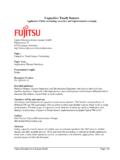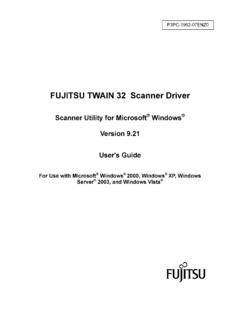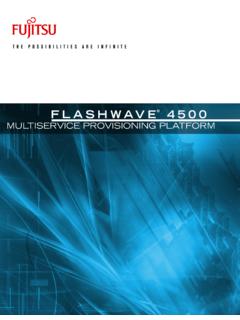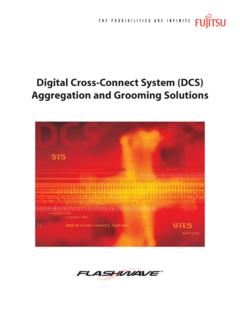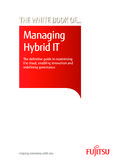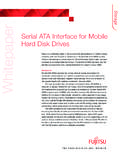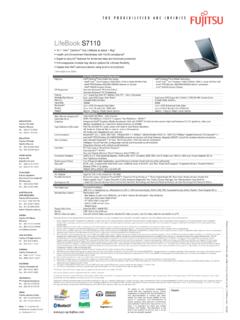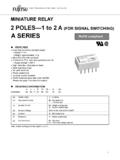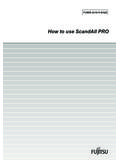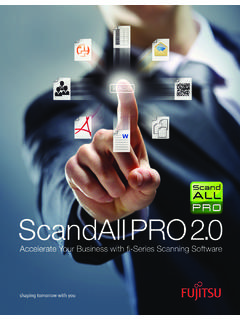Transcription of Remote Management Controller User's Guide - Fujitsu …
1 Remote Management Controller User's Guide Areas Covered Before Reading This Manual This section explains the notes for your safety and conventions used in this manual. Chapter 1 Overview of Remote Management Controller This chapter explains an overview of the Remote Management Controller . Please make sure to read these sections before using the Remote Management Controller . Chapter 2 Preparation This chapter explains preparation for using the Remote Management Controller . Chapter 3 Starting and Exiting This chapter explains how to start and exit the Web interface of the Remote Management Controller . Chapter 4 Setting and Referencing user Information This chapter explains the meaning and settings of each Web interface window of the Remote Management Controller . Appendix This chapter explains about the settings to use LDAP with the Remote Management Controller . 9. 1. Before Reading This Manual Remarks Symbols Symbols used in this manual have the following meanings: These sections explain prohibited actions and points to note when using this software.
2 Make sure to read these sections. These sections explain information needed to operate the hardware and software properly. Make sure to read these sections. This mark indicates reference pages or manuals. Key Descriptions / Operations Keys are represented throughout this manual in the following manner: : [Ctrl] key, [Enter] key, [ ] key, etc. The following indicate the pressing of several keys at once: : [Ctrl] + [F3] key, [Shift] + [ ] key, etc. Consecutive Operations Consecutive operations are described by connecting them with " ". Example: For the operation to click the [Start] button, point to [All Programs], and click [Accessories].. Click [Start] [All Programs] [Accessories]. CD/DVD Drive Descriptions In this manual, both CD-ROM and DVD-ROM drives are described as a CD/DVD-ROM drive. Select a proper drive depending on your environment. Entering Commands (Keys). Command entries are written in the following way: In the spaces indicated with the " " mark, press the [Space] key once.
3 CD/DVD drive letter is shown as [CD/DVD drive]. Enter your drive letter according to your environment. [CD/DVD drive]:\ 2. Operations for Linux The mount commands for CD/DVD drive and floppy disk drive differ depending on the version. Interpret "/mnt/cdrom/, /media/cdrom/ or /media/cdrecorder/" and "mnt or media/floppy" in this manual as follows depending on your Linux version. For RHEL-AS4(x86)/ES4(x86)/AS4(IPF). /media/cdrecorder, /media/floppy For RHEL5(x86)/RHEL5(Intel64)/RHEL-AS4(EM64T )/ES4(EM64T). /media/cdrom, /media/floppy ` For RHEL5(x86)/RHEL5(Intel64), perform the following procedure to mount drives. # mkdir /media/cdrom # mount /dev/cdrom /media/cdrom or # mkdir /media/floppy # mount /dev/floppy /media/floppy For RHEL-AS3(x86)/AS3(IPF)/ES3(x86). /mnt/cdrom, /mnt/floppy Screen Shots and Figures Screen shots and figures are used as visual aids throughout this manual. Windows, screens, and file names may vary depending on the OS, software, or configuration of the server used.
4 Figures in this manual may not show cables that are actually connected for convenience of explanation. 9. 3. Abbreviations The following expressions and abbreviations are used throughout this manual. table: Abbreviations of Product Names Product name Expressions and abbreviations Windows Server 2008 or Windows Microsoft Windows Server 2008, Standard Windows Server 2008 (64-bit). Microsoft Windows Server 2008, Enterprise Microsoft Windows Server 2008, Datacenter Microsoft Windows Server 2008, Standard without Hyper-V . Microsoft Windows Server 2008, Enterprise without Hyper-V . Microsoft Windows Server 2008, Datacenter without Hyper-V . Microsoft Windows Server 2003, Standard Edition Windows Server 2003. Microsoft Windows Server 2003, Enterprise Edition Microsoft Windows Server 2003, Standard x64 Edition Microsoft Windows Server 2003, Enterprise x64 Edition Microsoft Windows Server 2003, Enterprise Edition for Itanium- based Systems Microsoft Windows Small Business Server 2003. Microsoft Windows Server 2003 R2 Standard Edition Windows Server 2003 R2.
5 Microsoft Windows Server 2003 R2 Enterprise Edition Microsoft Windows Server 2003 R2 Standard x64 Edition Microsoft Windows Server 2003 R2 Enterprise x64 Edition Microsoft Windows Small Business Server 2003 R2. Microsoft Windows Storage Server 2003 R2, Standard Edition Microsoft Windows 2000 Server Windows 2000 Server Microsoft Windows 2000 Advanced Server Microsoft Windows Server Network Operating System Version Windows NT. Microsoft Windows NT Server, Enterprise Edition Microsoft Windows XP Professional Windows XP. Microsoft Windows 2000 Professional Windows 2000. Microsoft Windows NT Workstation Operating System Windows NT Red Hat Enterprise Linux 5 (for x86) Red Hat Linux Linux RHEL5(x86). Red Hat Enterprise Linux 5 (for Intel64) RHEL5(Intel64). Red Hat Enterprise Linux AS ( for x86) RHEL-AS4(x86). Red Hat Enterprise Linux ES ( for x86) RHEL-ES4(x86). Red Hat Enterprise Linux AS ( for EM64T) RHEL-AS4(EM64T). Red Hat Enterprise Linux ES ( for EM64T) RHEL-ES4(EM64T). Red Hat Enterprise Linux AS ( for x86) RHEL-AS3(x86).
6 Red Hat Enterprise Linux AS ( for Itanium) RHEL-AS3(IPF). Red Hat Enterprise Linux ES ( for x86) RHEL-ES3(x86). SUSE . LINUX Enterprise Server 9 for x86 SUSE Linux SLES9(x86). LDSM. Intel LANDesk Server Manager 4. table: Abbreviations of Product Names Product name Expressions and abbreviations Remote Service Board Remote Service Board (PG-RSB102/PG-RSB103/PG-RSB104/PG-RSB105 ). About the Server Core Installation Option The environment in which the Windows Server 2008 operating system is installed by the Server Core installation option is written as Server Core in this manual. Reference Information Supported OS Associated with Machine Types Some OS described in this manual may not be supported depending on machine types. Please confirm the supported OS for your server in the manuals supplied with each server. Latest Information about ServerView For the latest information regarding ServerView, refer to the Fujitsu PRIMERGY website (http://. ). Trademarks Microsoft, Windows, MS, MS-DOS, Windows Server and Hyper-V are trademarks or registered trademarks of Microsoft Corporation in the USA and other countries.
7 Intel and Pentium are trademarks or registered trademarks of Intel Corporation or its subsidiaries in the USA and other countries. Linux is a trademark or registered trademark of Linus Torvalds in the USA and other countries. Red Hat and all Red Hat-based trademarks and logos are trademarks or registered trademarks of Red Hat, Inc. in the USA and other countries. SUSE is a registered trademark of SUSE LINUX AG, a Novell business. All other hardware and software names used are trademarks or registered trademarks of their respective manufacturers. Other product names are copyrights of their respective manufacturers. Copyright Fujitsu LIMITED 2008. Screen shot(s) reprinted with permission from Microsoft Corporation. 9. 5. 6. Contents Chapter 1 Overview of Remote Management Controller Remote Management Controller .. 10. Supported Models and Functions ..10. Notes .. 11. Chapter 2 Preparation Preparation .. 14. Setting IP Address ..14. Setting user Name and Password ..14. Communication Protocol of Remote Management Controller .
8 16. Chapter 3 Starting and Exiting Starting Web Interface .. 18. Operating Web Interface .. 20. Web Interface Menu List ..21. Exiting Web Interface .. 23. Chapter 4 Setting and Referencing user Information System Information .. 26. System Overview ..26. System Component Information ..28. iRMC S2 .. 29. iRMC S2 Information ..29. Setting License Key for Remote Management Controller ..30. Save iRMC S2 Firmware Settings ..31. Certificate Upload ..32. Generate a self signed RSA Certificate ( or later) ..33. Power Management .. 35. Power On/Off ..35. Power Options ..37. Power Supply Information ( or later) ..38. Power Consumption .. 40. Power Consumption Configuration ([iRMC S2] only) ..40. Power Consumption History ([iRMC S2] only) ..42. Sensors .. 44. Fans ..44. Temperature ..47. Voltages and Current ..49. 7. Power Supply .. 51. Component Status .. 52. System Event Log .. 53. System Event Log Content .. 53. System Event Log Configuration .. 55. Server Management Information .. 56. Network Settings.
9 58. Network Interface .. 58. Ports and Network Services .. 60. DHCP Configuration .. 62. DNS Configuration .. 63. Alerting .. 64. SNMP Trap Alerting .. 64. Email Alerting .. 65. user Management .. 67. user Management .. 67. Directory Service Configuration .. 72. Console Redirection .. 74. BIOS Text Console .. 74. Advanced Video Redirection .. 75. Video Redirection Window Layout .. 79. Enabling Mouse Cursor Synchronization .. 81. Remote Storage Connection .. 83. Graphical Keyboard .. 86. Mouse and Keyboard Settings .. 87. Remote Storage .. 89. iRMC S2 SSH Access .. 91. How to Connect and Close iRMC .. 91. Main Menu .. 92. iRMC S2 Telnet Access .. 93. Session Logout .. 94. Appendix A Settings for using LDAP .. 96. 8. Chapter 1. Overview of Remote Management Controller This chapter explains an overview of the Remote Management Controller . Remote Management Controller .. 10. Notes .. 11. 9. Chapter 1 Overview of Remote Management Controller Remote Management Controller The Remote Management Controller adds the Remote Service Board (RSB) function to the Baseboard Management Controller (BMC) on the baseboard (On Board).
10 It enables status confirmation and setting of a remotely located server, and also power control. This section describes the Web interface to access the Remote Management Controller from Remote locations and to operate it. Supported Models and Functions z Models Supported by the Remote Management Controller The Remote Management Controller has normal iRMC and iRMC S2. iRMC S2 has extended Pre- failure Detection Analysis (PDA) functions for memory and CPU. iRMC and iRMC S2 support IPMI. , and each is installed on the different server. z Web Interface Functions of the Remote Management Controller The Web interface of the Remote Management Controller has the following functions: Display system informationJ" System Information" ( ). Control server (restart, power on/off)J" Power Management " ( ). Display sensor status (fan, temperature, voltage, power supply)J" Sensors" ( ). Display logJ" System Event Log" ( ). Display and set server control informationJ" Server Management Information" ( ).
